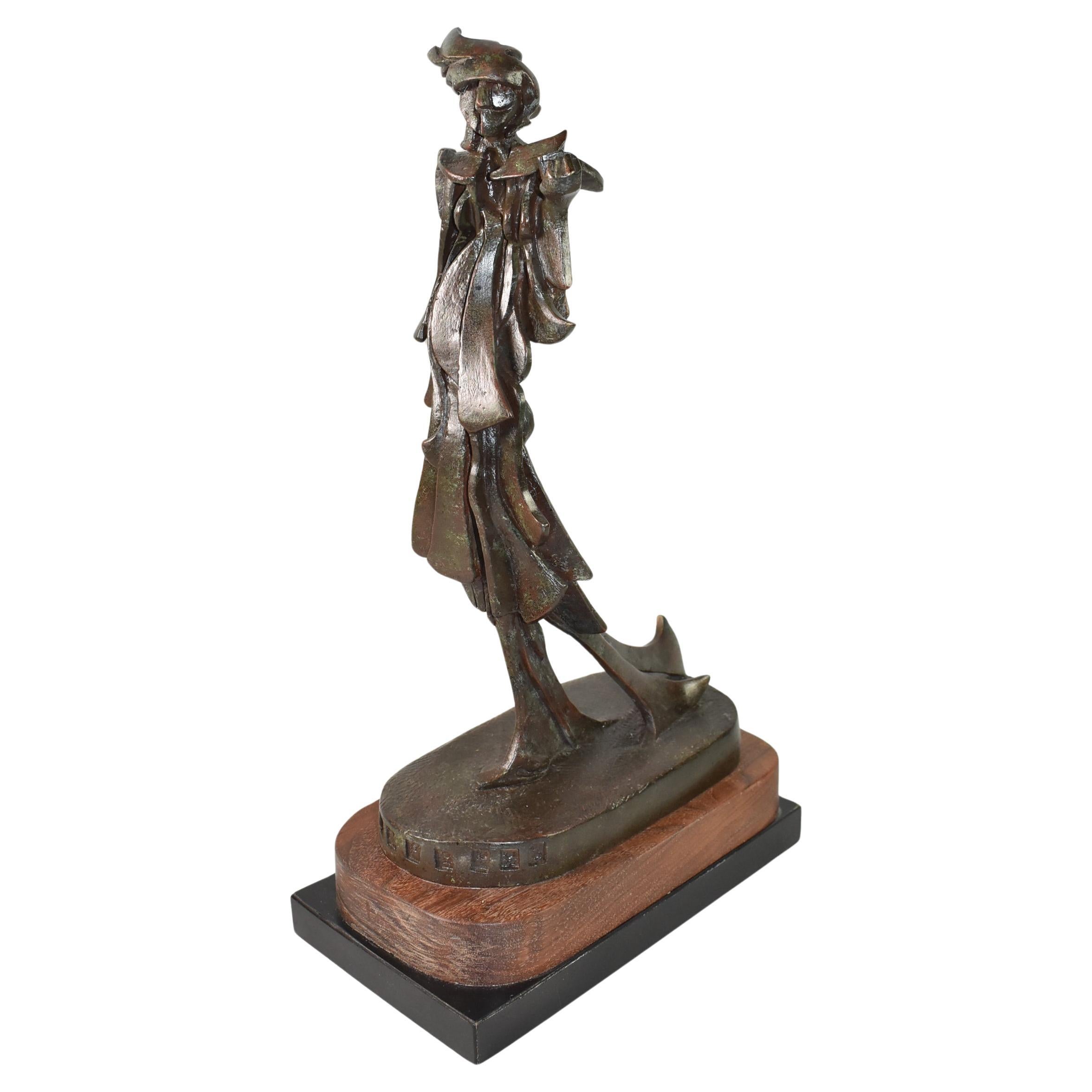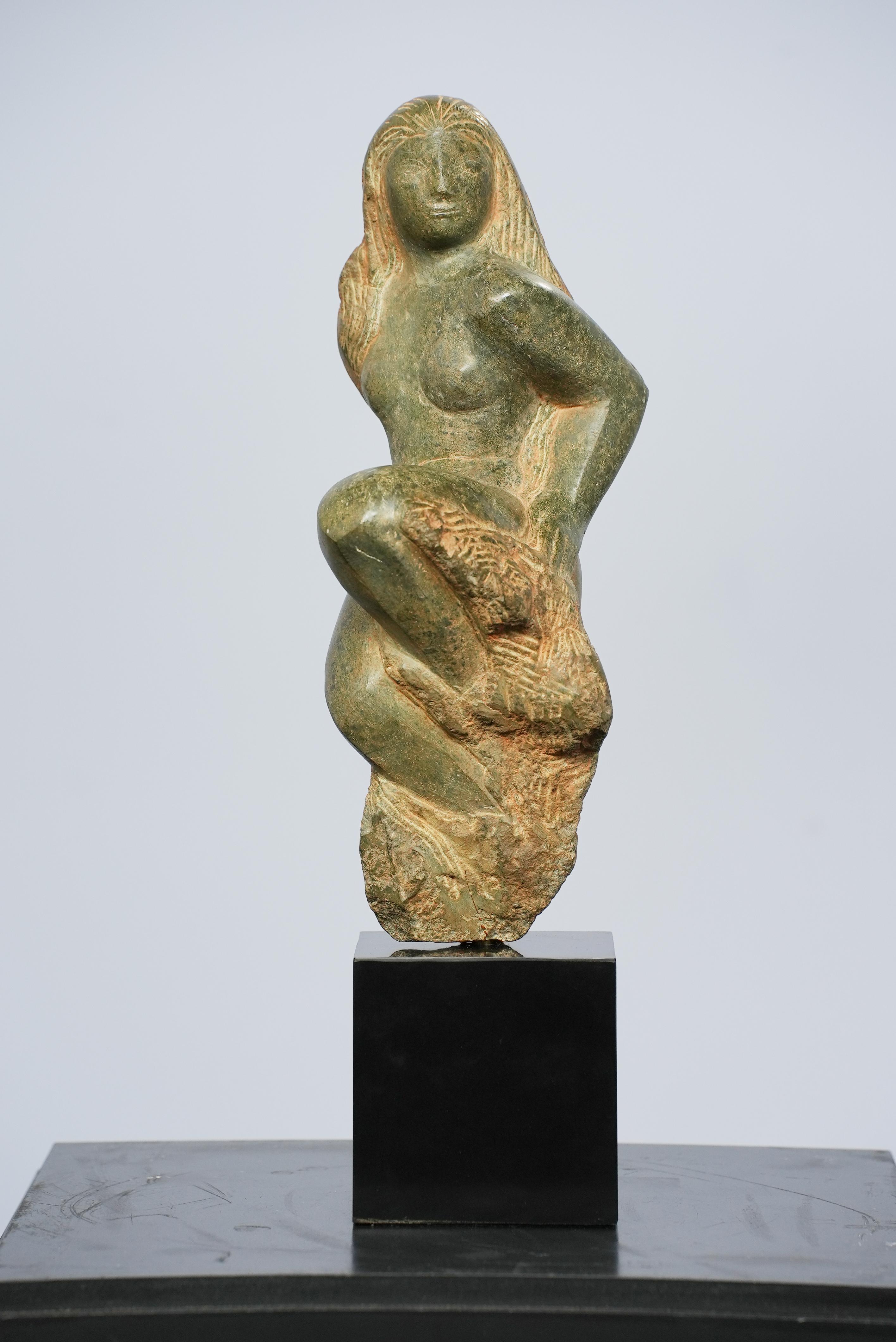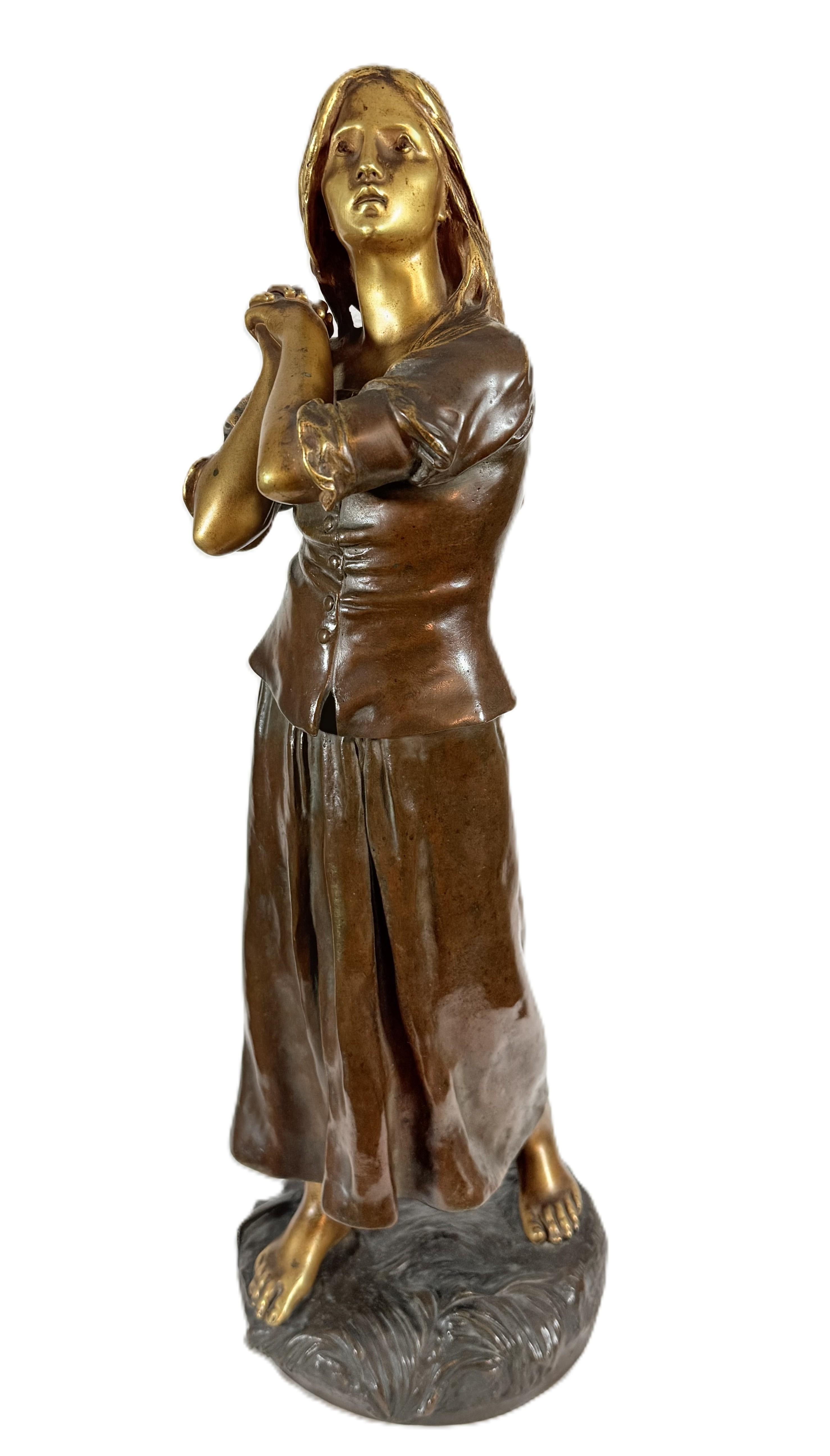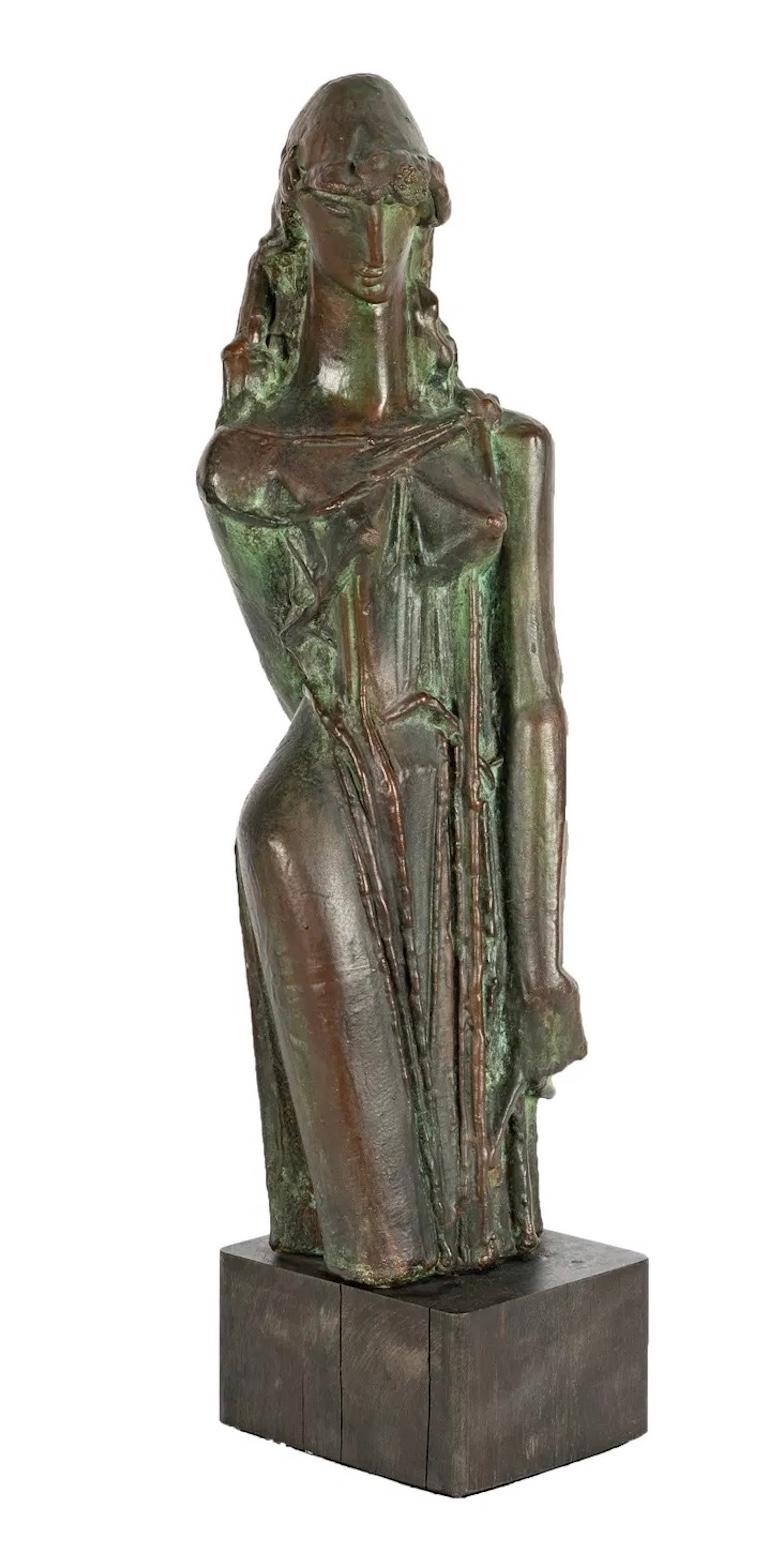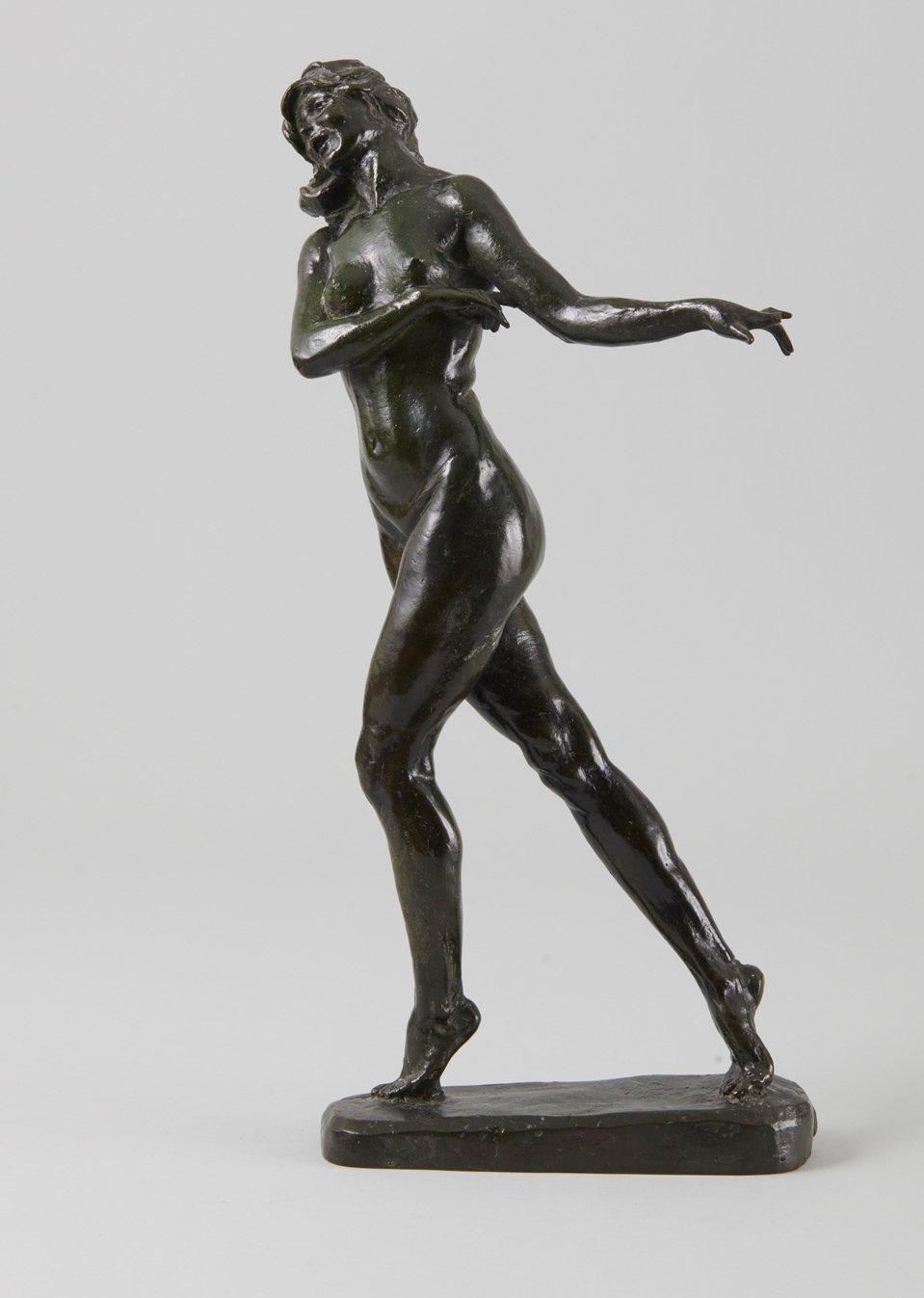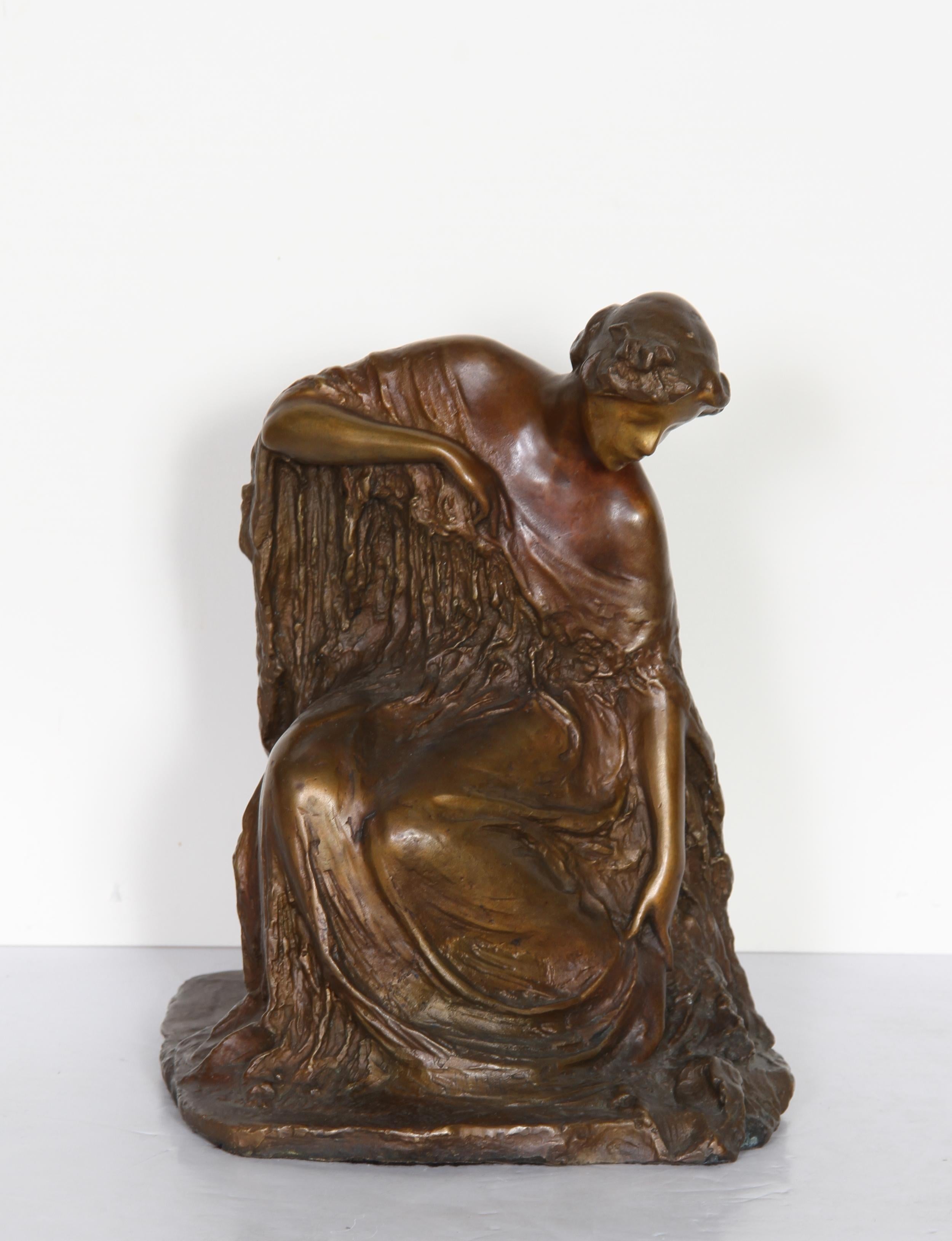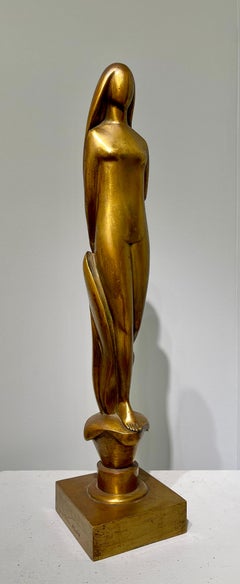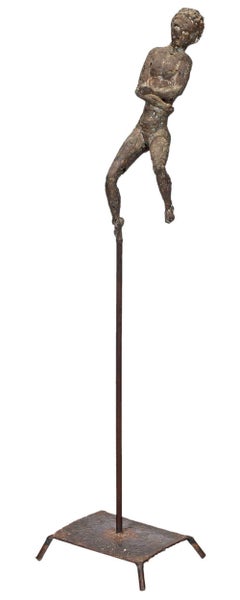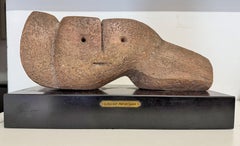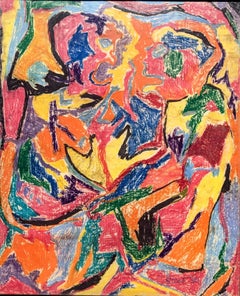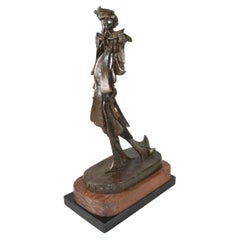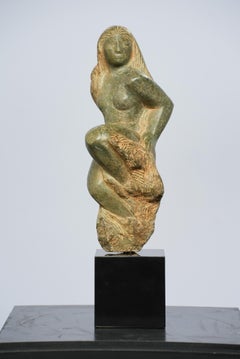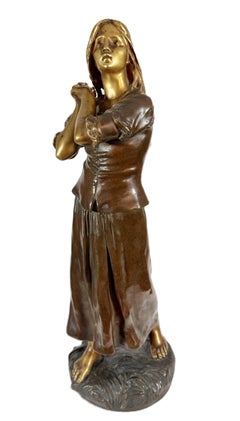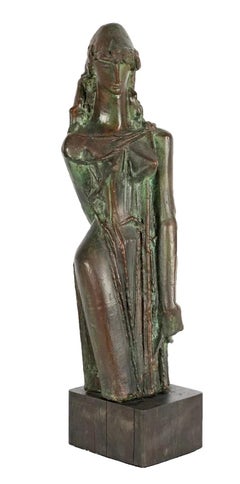Items Similar to "Stepping Out" Margarett W. McKean Sargent, Female Figure, Emerging Forms
Want more images or videos?
Request additional images or videos from the seller
1 of 2
Margarett W. McKean Sargent"Stepping Out" Margarett W. McKean Sargent, Female Figure, Emerging Forms1916
1916
$30,000
£22,767.62
€26,225
CA$42,870.26
A$47,049.70
CHF 24,264.85
MX$562,042.65
NOK 307,480.70
SEK 288,123.72
DKK 195,851.38
About the Item
Margarett W. McKean Sargent
Stepping Out, 1916
Signed and dated on base
Bronze
14 x 6 x 8 inches
Provenance
Private Collection, Hingham, Massachusetts
Walker-Cunningham Fine Art, St. Louis, Missouri, 2007
Exhibited
New York, Hawthorne Fine Art, Breaking All Bounds: American Women Artists (1825-1945), November 1, 2018 - January 11, 2019.
Margarett W. McKean Sargent was born on Commonwealth Avenue in Boston’s Back Bay in on Aug. 31, 1892 to Francis Sargent and Jane Welles Hunnewell. Her maternal grandfather, Horatio Hollis Hunnewell, was a railroad baron who spent much of his spare time importing and cultivating rhododendrons. Margarett took more pride in her paternal ancestors, who she viewed as more distinguished. The first Sargent had arrived in Massachusetts in 1689.
At the age of 16 her family sent her to Miss Porter’s in Farmington, Connecticut. After boarding school she agreed to marry Eddie Morgan, a wealthy friend of her brother’s.
After spending a year studying art in Florence, Margarett W. McKean Sargent returned to Boston in 1914, where she studied with a rising young sculptress named Bashka Paeff. Margarett Sargent had talent and she worked hard at her art. In 1916, she began to reap the rewards, with two works exhibited at the Art Institute of Chicago. A year later, she showed two more at the National Academy of Design.
In 1917, she went to study with Gutzon Borglum in Connecticut. There she met and befriended George Luks – a prominent member of the Ashcan School of art. He later painted her portrait from memory, and called it The White Blackbird – a title her granddaughter would use in a biography of her. In 1919 she moved to New York, where she took an apartment with a friend – and probably lover – named Marjorie Davenport. She pursued avant-garde painting and sculpture and hung out with Harpo Marx and her downstairs neighbor, Fanny Brice.
Her Bohemian revel was short lived, however. The next year she married Quincy Adams Shaw McKean. He succeeded at dog breeding and polo playing, but business, not so much. Fortunately for him, his mother gave him an allowance to help pay for their 13 servants.
He and Margarett expanded their house and property into a 54-acre estate and Yankee palace, which included a large studio for her. Shaw encouraged her art, and they had four children in three years.
She had a one-woman show in 1926 at the prestigious Kraushaar Gallery in New York. She had her last exhibit in 1932 in Boston at the Doll and Richards Gallery.
- Creator:Margarett W. McKean Sargent (1892 - 1978, American)
- Creation Year:1916
- Dimensions:Height: 14 in (35.56 cm)Width: 6 in (15.24 cm)Depth: 8 in (20.32 cm)
- Medium:
- Movement & Style:Ashcan School
- Period:
- Condition:
- Gallery Location:New York, NY
- Reference Number:1stDibs: LU1841217090042
About the Seller
5.0
Platinum Seller
Premium sellers with a 4.7+ rating and 24-hour response times
Established in 2022
1stDibs seller since 2022
126 sales on 1stDibs
Typical response time: <1 hour
- ShippingRetrieving quote...Shipping from: New York, NY
- Return Policy
Authenticity Guarantee
In the unlikely event there’s an issue with an item’s authenticity, contact us within 1 year for a full refund. DetailsMoney-Back Guarantee
If your item is not as described, is damaged in transit, or does not arrive, contact us within 7 days for a full refund. Details24-Hour Cancellation
You have a 24-hour grace period in which to reconsider your purchase, with no questions asked.Vetted Professional Sellers
Our world-class sellers must adhere to strict standards for service and quality, maintaining the integrity of our listings.Price-Match Guarantee
If you find that a seller listed the same item for a lower price elsewhere, we’ll match it.Trusted Global Delivery
Our best-in-class carrier network provides specialized shipping options worldwide, including custom delivery.More From This Seller
View All"Young Woman Nude" Warren Wheelock, Art Deco, Modernist Female Sculpture Form
By Warren Wheelock
Located in New York, NY
Warren Wheelock
Untitled (Young Woman Nude), 1924
Incised signature and date to edge of base "© 1924 by Warren Wheelock"
Bronze
Sculpture: 20 h × 4½ w...
Category
1920s Art Deco Figurative Sculptures
Materials
Bronze
"Dancer" David Hare, Male Nude, Figurative Sculpture, Mid-Century Surrealist
By David Hare
Located in New York, NY
David Hare
Dancer, circa 1955
Bronze with integral stand
68 high x 17 wide x 13 1/2 deep inches
“Freedom is what we want,” David Hare boldly stated in 1965, but then he added the caveat, “and what we are most afraid of.” No one could accuse David Hare of possessing such fear. Blithely unconcerned with the critics’ judgments, Hare flitted through most of the major art developments of the mid-twentieth century in the United States. He changed mediums several times; just when his fame as a sculptor had reached its apogee about 1960, he switched over to painting. Yet he remained attached to surrealism long after it had fallen out of official favor. “I can’t change what I do in order to fit what would make me popular,” he said. “Not because of moral reasons, but just because I can’t do it; I’m not interested in it.”
Hare was born in New York City in 1917; his family was both wealthy and familiar with the world of modern art. Meredith (1870-1932), his father, was a prominent corporate attorney. His mother, Elizabeth Sage Goodwin (1878-1948) was an art collector, a financial backer of the 1913 Armory Show, and a friend of artists such as Constantin Brancusi, Walt Kuhn, and Marcel Duchamp.
In the 1920s, the entire family moved to Santa Fe, New Mexico and later to Colorado Springs, in the hope that the change in altitude and climate would help to heal Meredith’s tuberculosis. In Colorado Springs, Elizabeth founded the Fountain Valley School where David attended high school after his father died in 1932. In the western United States, Hare developed a fascination for kachina dolls and other aspects of Native American culture that would become a recurring source of inspiration in his career.
After high school, Hare briefly attended Bard College (1936-37) in Annandale-on-Hudson. At a loss as to what to do next, he parlayed his mother’s contacts into opening a commercial photography studio and began dabbling in color photography, still a rarity at the time [Kodachrome was introduced in 1935]. At age 22, Hare had his first solo exhibition at Walker Gallery in New York City; his 30 color photographs included one of President Franklin Roosevelt.
As a photographer, Hare experimented with an automatist technique called “heatage” (or “melted negatives”) in which he heated the negative in order to distort the image. Hare described them as “antagonisms of matter.” The final products were usually abstractions tending towards surrealism and similar to processes used by Man Ray, Raoul Ubac, and Wolfgang Paalen.
In 1940, Hare moved to Roxbury, CT, where he fraternized with neighboring artists such as Alexander Calder and Arshile Gorky, as well as Yves Tanguy who was married to Hare’s cousin Kay Sage, and the art dealer Julian Levy. The same year, Hare received a commission from the American Museum of Natural History to document the Pueblo Indians. He traveled to Santa Fe and, for several months, he took portrait photographs of members of the Hopi, Navajo, and Zuni tribes that were published in book form in 1941.
World War II turned Hare’s life upside down. He became a conduit in the exchange of artistic and intellectual ideas between U.S. artists and the surrealist émigrés fleeing Europe. In 1942, Hare befriended Andre Breton, the principal theorist of surrealism. When Breton wanted to publish a magazine to promote the movement in the United States, he could not serve as an editor because he was a foreign national. Instead, Breton selected Hare to edit the journal, entitled VVV [shorth for “Victory, Victory, Victory”], which ran for four issues (the second and third issues were printed as a single volume) from June 1942 to February 1944. Each edition of VVV focused on “poetry, plastic arts, anthropology, sociology, (and) psychology,” and was extensively illustrated by surrealist artists including Giorgio de Chirico, Roberto Matta, and Yves Tanguy; Max Ernst and Marcel Duchamp served as editorial advisors.
At the suggestion of Jacqueline Lamba...
Category
1950s Abstract Figurative Sculptures
Materials
Bronze
$20,000 Sale Price
20% Off
"Abstract Figure with Face" Louise Nevelson, American Female, Anthropomorphic
By Louise Nevelson
Located in New York, NY
Louise Nevelson
Abstract Figure with Face, circa 1945
Incised "LN" on the reverse
Tattistone
6 inches high x 14 inches wide x 5 1/4 inches deep
Provenance
The artist
The artist's ni...
Category
1940s American Modern Abstract Sculptures
Materials
Cast Stone
"Two Figures, " Louis Stone, Abstract, American WPA Modernism
By Louis Stone
Located in New York, NY
Louis K. Stone (1902 - 1984)
Two Figures, 1980
Mixed media on paper
Sight 52 x 42 inches
Signed and dated lower right
Louis King Stone was born in Findlay, Ohio in 1902 and received...
Category
1980s Abstract Abstract Paintings
Materials
Paper, Mixed Media
"Reclining Woman" Karl Bitter, Reclining Woman with Reddish Patina
Located in New York, NY
Karl Bitter
Reclining Woman, 1897
Signed: Bitter 97
Stamped: GORHAM M F G CO.
Bronze
10.25 x 10.25 x 4 inches
Initially from Vienna, Karl Bitter first studied art at the city’s Kunstgewerbeschule and the Kunstakademie before being drafted into the Austrian army. He deserted his position in the military while on leave, and departed for New York City where he would discover considerable success. Early on, he won a competition for the Astor memorial bronze gates at Trinity Church, which awarded him enough capital to open his own studio. He went on to execute sculptures of Alexander Hamilton and Thomas Jefferson at the Cuyahoga Courthouse in Cleveland; he also created portraits of Jefferson for the state of Missouri and the University of Virginia. These commissions caught the attention of sculptor Richard Morris Hunt (who famously designed the façade of the Metropolitan Museum), earning Bitter the duty of producing the portrait medallions that now appear near the top of the museum’s grand face.
Notably, he presented at Chicago’s 1893 World’s Columbian Exposition and directed the Pan-American Exposition in Buffalo in 1901. Over his career, his artwork became more flexible – his early academy training is easily identifiable within his work, but after moving to America, conventions of Modernism became more prevalent within his sculpture. In addition to many awards, Bitter presided over the National Sculpture Society in 1906-1907, and was a member of the National Institute of Arts and Sciences, the National Academy of Design, the American Academy of Arts and Letters, the Architectural League, and the Art Commission, New York. His public work can be found at the Biltmore Estate, Asheville, NC; Gettysburg National Military Park, Gettysburg, PA; Wisconsin State Capitol, Madison, WI; United States Naval Academy...
Category
1890s Realist Figurative Sculptures
Materials
Bronze
"Zofar" Boaz Vaadia, Human Body, Bronze and Stone, Anthropomorphic Sculpture
By Boaz Vaadia
Located in New York, NY
Boaz Vaadia
Zofar, 1997
Bronze, bluestone, and boulder
Overall 20 x 29 x 27 inches
From the edition of 7
Provenance
Elaine Baker Gallery, Boca Raton, Florida
Boaz Vaadia is the in...
Category
1990s American Modern Figurative Sculptures
Materials
Stone, Bluestone, Bronze
You May Also Like
Carole Harrison Bronze Sculpture "Stride"
Located in Toledo, OH
Bronze sculpture by Carole Harrison titled "Stride", 2014. 16" tall x 9" wide x 5" deep. Signed and dated.
Carole Harrison (10/30/33 - 4/4/22) - Born in Illinois, Carole studied at...
Category
21st Century and Contemporary Figurative Sculptures
Materials
Bronze
Female Figure
By Lorrie Goulet
Located in New York, NY
It is marvelous to find discoveries such as Lorrie Goulet's female form, one of our few American women sculptors who direct carved in marble. Goulet has an attractive technique of u...
Category
1960s American Modern Figurative Sculptures
Materials
Marble
Raoul Fançois Larche Patinated bronze figure of a woman
Located in Berlin, DE
FRANCOIS-RAOUL LARCHE 1860 SAINT-ANDRÉ-DE-CUBZAC - 1912 PARIS
Signed on the base with "RAOUL LARCHE," foundry mark "SIOT DECAUVILLE PARIS FONDEUR," and number "R 276."
Total height...
Category
Early 1900s Jugendstil Figurative Sculptures
Materials
Bronze
"Naomi" Mid 20th Century American Bronze Sculpture Female Portrait Figurative
Located in New York, NY
"Naomi" Mid 20th Century American Bronze Sculpture Female Portrait Figurative
Albert W. Wein (1915-1991)
"Naomi"
Bronze, c. 1960s
Signed
Figure: 19 1/2 x 5 1/2 x 5 inches
Overall he...
Category
1960s American Modern Figurative Sculptures
Materials
Bronze
Nude Walking, Early 20th Century Bronze Sculpture, Cleveland School Artist
By Max Kalish
Located in Beachwood, OH
Max Kalish (American, 1891-1945)
Nude Walking, 1930
Bronze
Signed and dated on base
17 x 9 x 4 inches
Born in Poland March 1, 1891, figurative sculptor Max Kalish came to the United States in 1894, his family settling in Ohio. A talented youth, Kalish enrolled at the Cleveland Institute of Art as a fifteen-year-old, receiving a first-place award for modeling the figure during studies with Herman Matzen. Kalish went to New York City following graduation, studying with Isidore Konti and Herbert Adams...
Category
1930s American Modern Figurative Sculptures
Materials
Bronze
Woman Dressing, Bronze Sculpture by Bessie Potter Vonnoh 1911
By Bessie Potter Vonnoh
Located in Long Island City, NY
This bronze sculpture by Bessie Potter Vonnoh, from 1911, is a charming rendering of a young woman dressing.
Vonnoh became one of the so-called "White Rabbits", women artists who a...
Category
1910s Art Nouveau Figurative Sculptures
Materials
Bronze
